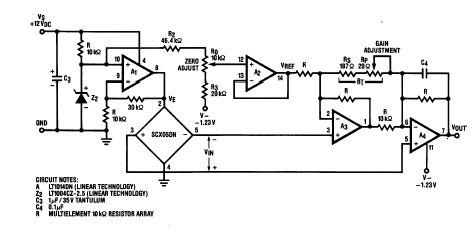The circuit we are going to introduce is suggested by Honeywell (www.honeywell.com) and is suitable for computerized control applications. The output of this amplifier allows the use of pressure sensors and others with the same characteristics with ADCs operating in the 0 to 5 V range.
Since most of the amplifiers used for this purpose do not have a range from 0 to the supply voltage but from 100 mV when using a single source, this may be a limitation of the design. The idea presented is to use a negative source to allow the amplifier to start from zero. This is precisely what is suggested in this application.
Thus, we start from the negative power supply, shown in figure 1, which makes use of a voltage converter LTC1044 (Linear Technology) to generate a negative voltage of -1.23 V from a single 12 V supply. In this circuit, the four diodes in series provide an input voltage of approximately 2.4 V for the circuit which, through a capacitor switching technique, enables the polarity to be reversed at the output.
The output voltage is then regulated by a zener diode (Z1) thus providing the negative 1.23V that will be used in the power supply of the amplifier.

The complete amplifier circuit is shown in figure 2, based on a Linear Technology LT1014DV quadruple operating amplifier. We also note that this circuit uses an array of multi-element resistors ® for a compact assembly.
The trimpot Ro makes the circuit's null adjustment which for the suggested sensor can measure pressures from 0 mm Hg to 250 mm Hg with the Honeywell SCX05DN sensor. To adjust, initially set the null with the sensor in the vacuum and then apply the maximum pressure, adjusting Rp so that the output is full scale or 5 V.





